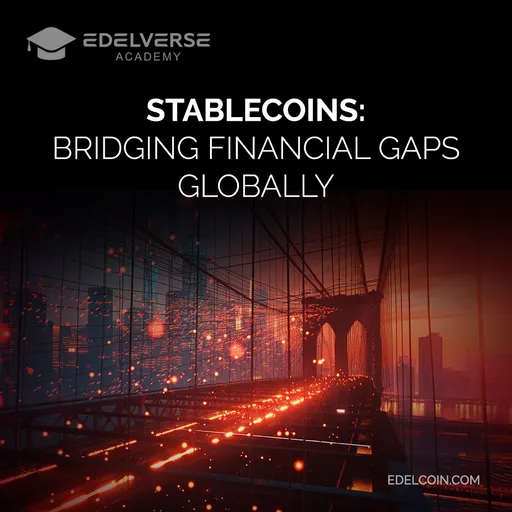
CBDCs vs. Decentralized Stablecoins
Where Edelcoin Fits in the Evolving Landscape
The financial ecosystem is witnessing a pivotal transformation with the emergence of Central Bank Digital Currencies (CBDCs) and decentralized stablecoins. These digital assets are redefining monetary transactions, financial inclusion, and the global economy's digitalization pace. This article delves into the nuances of CBDCs and decentralized stablecoins, comparing their functionalities, benefits, and limitations, while highlighting Edelcoin's unique position in this evolving landscape.
From this article, you will know...
- The key differences between CBDCs and decentralized stablecoins.
- Examples of countries that have implemented CBDCs.
- The benefits and challenges of both CBDCs and decentralized stablecoins.
- Edelcoin's unique approach within the digital currency landscape.
Introduction
The digital currency space is broadly categorized into two segments: CBDCs, issued by central banks, and decentralized stablecoins, typically pegged to fiat currencies but operated on blockchain technology without central authority. As of recent developments, over 87 countries are exploring or have launched CBDCs, signifying a shift towards digitized national currencies.
Understanding CBDCs
CBDCs represent the digital form of a country's fiat currency, aiming to enhance payment efficiency, bolster financial inclusion, and streamline monetary policy implementation. Unlike traditional money, CBDCs offer a digital alternative directly issued and regulated by the nation's central bank, ensuring full legal tender status. Countries like Jamaica, Nigeria, and the Bahamas are at the forefront, with Jamaica's JAM-DEX becoming the first CBDC formally recognized as legal tender.
Benefits and Challenges of CBDCs
CBDCs promise reduced transaction costs, increased financial inclusion for the unbanked population, and enhanced security and speed in payments. However, the introduction of CBDCs also raises concerns about privacy, potential instability in the financial system, and the risk of cyber threats.
Decentralized Stablecoins: A Contrast
Decentralized stablecoins, such as Tether (USDT) and USD Coin (USDC), are pegged to stable assets like the US dollar but operate on decentralized blockchain technology. They offer the benefits of cryptocurrencies, including transparency, security, and efficiency, without the typical volatility associated with digital currencies like Bitcoin.
Advantages and Disadvantages
The primary advantage of decentralized stablecoins lies in their ability to facilitate global transactions with minimal fees, instant processing times, and without the need for traditional banking systems. However, they also face scrutiny over their backing reserves, regulatory compliance, and the potential for market manipulation.
Where Edelcoin Fits In
Edelcoin represents a novel intersection in the digital currency spectrum, bridging the gap between Central Bank Digital Currencies (CBDCs) and the broader crypto market. While CBDCs are state-backed digital currencies designed to digitize the fiat system and enhance monetary policy implementation, decentralized cryptocurrencies offer a new form of financial freedom without central oversight. Edelcoin, with its metal-backed stability and operation on the Ethereum blockchain, introduces a hybrid model that combines the security and reliability expected of CBDCs with the innovation and flexibility of the crypto world.
This stablecoin's unique backing by a diversified basket of metals and its Swiss regulatory compliance position it as a secure, stable asset amidst the volatility typically associated with cryptocurrencies. Moreover, its integration into centralized exchanges enhances liquidity and accessibility, making it an appealing option for users seeking stability in the crypto space without disconnecting from the dynamism of blockchain technologies. As the digital currency landscape continues to evolve, Edelcoin's model could serve as a blueprint for future projects looking to meld the assurance and stability of CBDCs with the revolutionary potential of cryptocurrency.
The Evolving Landscape
The introduction of CBDCs and the growth of decentralized stablecoins represent a shift towards a more digitized, efficient, and inclusive financial system. Each has its role to play, with CBDCs enhancing national monetary policies and stablecoins facilitating global commerce. Edelcoin's position in this landscape signifies a potential for innovation in bridging traditional financial systems with the new age of digital finance.
Future Directions
As the digital currency landscape continues to evolve, the success of platforms like Edelcoin will depend on regulatory adaptability, technological advancements, and market acceptance. The collaboration between central banks, financial institutions, and blockchain platforms will be crucial in shaping a financial ecosystem that is secure, efficient, and accessible to all.
Conclusion
The journey towards a fully digitized financial ecosystem is underway, with CBDCs and decentralized stablecoins paving the path. Edelcoin represents an intriguing development in this space, potentially harmonizing the strengths of both worlds. As the global economy continues to digitize, the role of digital currencies like Edelcoin will become increasingly significant, offering new opportunities for financial inclusion, efficiency, and stability.

- What is a Central Bank Digital Currency (CBDC)?
a. A decentralized cryptocurrency like Bitcoin.
b. A digital currency issued and regulated by a country's central bank.
c. A private digital currency backed by physical commodities like gold. - Which country was among the first to formally recognize a CBDC as legal tender?
a. The United States.
b. Jamaica, with its JAM-DEX.
c. Switzerland. - How does Edelcoin aim to differentiate itself in the digital currency market?
a. By being the first decentralized cryptocurrency.
b. By acting as a CBDC.
c. By backing its value with physical commodities.
Correct answers: 1b, 2b, 3c.
Contents





